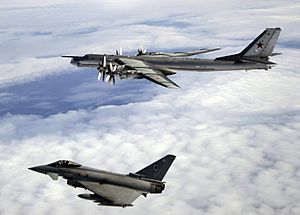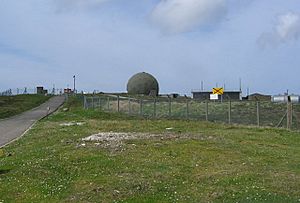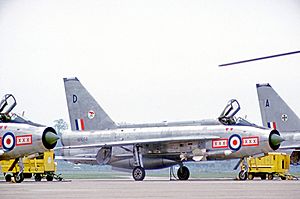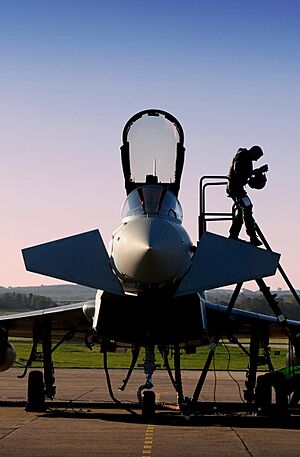Quick Reaction Alert facts for kids
Quick Reaction Alert (QRA) is a special way that air forces, especially those in NATO, keep their planes ready to fly very quickly. It means pilots and planes are on standby 24 hours a day, ready to take off in minutes. The United States calls this 'Airspace Control Alert'.
Some countries that are not part of NATO also have a QRA system, either all the time or at certain hours.
Contents
How Quick Reaction Alert Works
QRA in the United Kingdom
Pilots and engineers on QRA duty are always ready. They stay in a special room near the hangars, which are called Q-sheds. These sheds hold the Eurofighter Typhoon planes, which are used for intercepts. Pilots usually do a 24-hour QRA shift once or twice a month.
Engineers are on QRA duty three or four times a year, for seven days at a time. Two Typhoon planes are kept ready. A Voyager tanker plane is also ready at RAF Brize Norton to refuel the fighter jets in the air.
Air traffic in the UK is watched by a group called NATS Holdings. They have control centers that cover different parts of the sky. The RAF also has a team at the main control center in Swanwick.
Military radar in the UK is managed by the UK Air Surveillance and Control System (ASACS). They have special radar stations called Remote Radar Heads (RRH) across the country. These radars help them see everything flying in the sky.
Some of these radar stations are at:
- RRH Benbecula in the Outer Hebrides
- RRH Saxa Vord in Shetland
- RRH Buchan near Peterhead
- RRH Staxton Wold in North Yorkshire
QRA in the United States
In the United States, Quick Reaction Alert is known as Airspace Control Alert. It works in a similar way, keeping planes ready to respond quickly to any air threats.
QRA Stations Around the World
Many countries have QRA bases to protect their skies. Here are a few examples:
Austria
Austria's air force has QRA readiness only during the daytime. Their Eurofighter Typhoon jets are based at Zeltweg Air Base.
Baltic States
Lithuania, Latvia, and Estonia are part of NATO but do not have their own fighter jets for QRA. Other NATO countries take turns providing air defence for them.
Germany
The German Air Force uses Eurofighter Typhoons for QRA. They have main QRA bases at Wittmund (for the North) and Neuburg Air Base (for the South).
Italy
The Italian Air Force uses both Typhoon and F-35 jets for QRA. They have squadrons at several air bases, including Grosseto Air Base and Gioia del Colle Air Base. Italy was the first country to use the Typhoon for QRA duty in December 2005.
Netherlands
The Royal Netherlands Air Force keeps F-16 planes on high alert at Volkel Air Base or Leeuwarden Air Base. They share the responsibility for QRA over Belgium, Netherlands, and Luxembourg (Benelux) with the Belgian Air Component.
United Kingdom
The UK has two main QRA RAF stations:
- RAF Coningsby in Lincolnshire covers the southern part of the UK, called QRA South.
- RAF Lossiemouth in Moray protects the northern part of the UK, known as QRA North.
History of Quick Reaction Alert
The idea of Quick Reaction Alert comes from the "scrambling" system used by RAF Fighter Command during the Battle of Britain. Scrambling meant pilots had to get into their planes and take off as fast as possible to meet enemy aircraft.
In the past, the UK used different planes for QRA. In the 1960s, Lightning jets were used. Later, Phantom jets took over. The Lightning was very fast, but the Phantom had better radar.
In August 2007, Russian planes started flying long-distance patrols again after many years. This led to more QRA intercepts. The Eurofighter Typhoon jets began taking over QRA duties from older Tornado planes.
For the 2012 Summer Olympics in London, part of the QRA South force was temporarily moved to RAF Northolt to help with security.
See also
- ACCS
- Baltic Air Policing
- NATO Integrated Air Defense System






